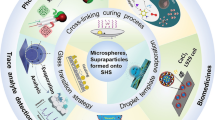Abstract
This paper describes the formation of a cytoprotective frame on mammalian cells and determines its impact on cell viability and creation of 3D tissue-like structures from cells modified by halloysite nanotubes and a polycation. Using the “hanging drop” method, spheroids were obtained from unmodified cells and cells modified with halloysite nanotubes and poly(acrylamide-co-diallyldimethyl-ammonium chloride). It has been shown that layer-by-layer modification of eukaryotic cells with the natural mineral halloysite and the polymer has little effect on their physiological parameters. Probably, the functionalization of the surface of cells by the nanoframe can be used for their protection from lethal factors, as well as for targeted drug delivery.

Similar content being viewed by others
References
Xiong, W., Yang, Z., Zhai, H., Wang, G., Xu, X., Ma, W., & Tang, R. (2013). Alleviation of high light-induced photoinhibition in cyanobacteria by artificially conferred biosilica shells. Chemical Communications, 49(68), 7525–7527.
Yang, S. H., Hong, D., Lee, J., Ko, E. H., & Choi, I. S. (2013). Artificial spores: cytocompatible encapsulation of individual living cells within thin, tough artificial shells. Small, 9(2), 178–186.
Rozhina, E. V., Danylushkina, A. A., Naumenko, E. A., Lvov, Y. M., & Fakhrullin, R. F. (2014). Halloysite nanotubes—a promising biocompatible material for “smart” composites with encapsulation of biologically active substances. Genes&Cells, 9(3), 25–28.
Lvov, Y. M., DeVilliers, M. M., & Fakhrullin, R. F. (2016). The application of halloysite tubule nanoclay in drug delivery. Expert Opinion on Drug Delivery, 13(7), 977–986.
Yang, S. H., Park, J. H., Cho, W. K., Lee, H. S., & Choi, I. S. (2009). Counteranion-directed, biomimetic control of silica nanostructures on surfaces inspired by biosilicification found in diatoms. Small (Weinheim An Der Bergstrasse, Germany), 5, 1947–1951.
Zanoni, M., Piccinini, F., Arienti, C., Zamagni, A., Santi, S., Polico, R., Bevilacqua, A., & Tesei, A. (2016). 3D tumor spheroid models for in vitro therapeutic screening: a systematic approach to enhance the biological relevance of data obtained. Scientific Reports, 6, 1–11.
Bellotti, C., Duchi, S., Bevilacqua, A., Lucarelli, E., & Piccinini, F. (2016). Long term morphological characterization of mesenchymal stromal cells 3D spheroids built with a rapid method based on entry-level equipment. Cytotechnology, 6(68), 2479–2490.
Dzamukova, M. R., Naumenko, E. A., Rozhina, E. V., Trifonov, A. A., & Fakhrullin, R. F. (2015). Cell surface engineering with polyelectrolyte-stabilized magnetic nanoparticles: a facile approach for fabrication of artificial multicellular tissue-mimicking clusters. Nano Research, 8(8), 2515–2532.
Funding Information
This work is supported by Russian Foundation for Basic Research (grant 16-34-00196).
Author information
Authors and Affiliations
Corresponding author
Ethics declarations
The work was performed according to the Russian Government Program of Competitive Growth of Kazan Federal University.
Rights and permissions
About this article
Cite this article
Rozhina, E., Ishmuhametov, I., Batasheva, S. et al. The Effect of Mammalian Cell Functionalization with Polycation and Halloysite Nanotubes on Intercellular Interactions. BioNanoSci. 8, 310–312 (2018). https://doi.org/10.1007/s12668-017-0453-8
Published:
Issue Date:
DOI: https://doi.org/10.1007/s12668-017-0453-8




